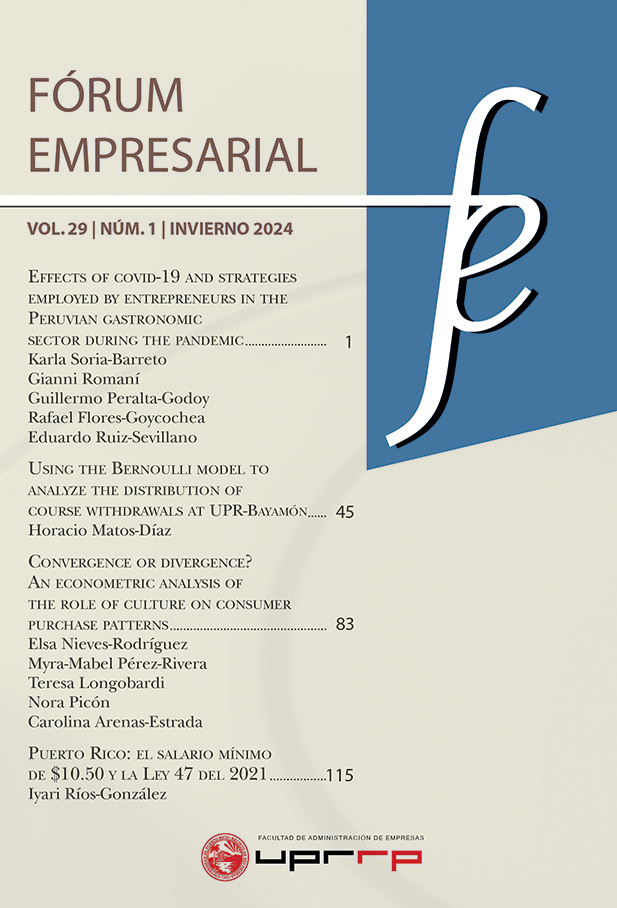Resumen
Usando un archivo longitudinal de los 39,337 cursos ofrecidos en la UPR-Bayamón durante 41 semestres consecutivos, se analiza la distribución de bajas parciales por curso a través de los primeros cuatro momentos: media, varianza, asimetría, y curtosis. Las características de los cursos, de los estudiantes, y muy particularmente, la heterogeneidad inobservable de los profesores, ejercen una fuerte y significativa influencia sobre el comportamiento de los momentos a través del tiempo. Parecería, que profesores y estudiantes están involucrados en un proceso de ir de compras que les beneficia mutuamente a expensas de los estándares académicos y de la calidad de la educación provista.
Citas
Adams, J. L., & Becker, W. E. (1990). Course withdrawals: a probit model and policy recommendations. Research in Higher Education, 31(6), 519-538. https://doi.org/10.1007/BF00992619
Bound, J., Lovenheim, M. F., & Turner, S. (2007). Understanding the decrease in college completion rates and the increased time to the baccalaureate degree (Research Report No. 07-626). Population Studies Center, University of Michigan. https://users.nber.org/~confer/2006/HIEDs06/bound.pdf
Bratsberg, B., & Rogeberg, O. (2018). Flinn effect and its reversal are both environmentally caused. PNAS, 115(26), 6674–6678. https://doi.org/10.1073/pnas.1718793115
Chow, Y.-L. (1989). Statistical analysis for business and economics. Elsevier.
Dilts, D. A. (1980). A statistical interpretation of student evaluation feedback. The Journal of Economic Education, 11(2), 10–15. https://doi.org/10.1080/00220485.1980.10844949
Dunwoody, P. T., & Frank, M. L. (1995). Why students withdraw from classes. The Journal of Psychology: Interdisciplinary and Applied, 129(5), 553–558. https://doi.org/10.1080/00223 980.1995.9914927
Dunwoody, P. T., & Frank, M. L. (1995). Why students withdraw from classes. The Journal of Psychology: Interdisciplinary and Applied, 129(5), 553–558. https://doi.org/10.1080/00223980.1995.9914927
Gump, S. E. (2007). Student evaluation of teaching effectiveness and the leniency hypothesis: a literature review. Educational Research Quarterly, 30, 55–68. https://files.eric.ed.gov/fulltext/EJ787711.pdf
Isely, P., & Singh, H. (2005). Do higher grades lead to favorable student evaluations? The Journal of Economic Education, 36(1), 29–42. https://doi.org/10.3200/JECE.36.1.29-42
Krautmann, A. C., & Sander, W. (1999). Grades and student evaluations of teachers. Economics of Education Review, 18(1),59–63. https://doi.org/10.1016/S0272-7757(98)00004-1
Matos-Díaz, H. (2012). Student evaluation of teaching, formulation of grade expectations, and instructor choice: explorations with random-effects ordered probability models. Eastern Economic Journal, 38, 296–309. https://doi.org/10.1057/eej.2011.7
Matos-Díaz, H. (2014). Measuring grade inflation and grade divergence accounting for student quality, Cogent Economics & Finance, 2(1), 1–16. http://dx.doi.org/10.1080/23322039.2014.915756
Matos-Díaz, H. (2018). Estimating the effects of partial withdrawals on GPA through time: evidence from the University of Puerto Rico. EconomiA, 19(1), 90–114. https://doi.org/10.1016/j.econ.2017.10.004
Matos-Díaz, H., & García-Vázquez, D. (2014). Modeling college graduation GPA considering equity in admissions: evidence from the University of Puerto Rico. Education Policy Analysis Archives 22(96), 1–33. http://dx.doi.org/10.14507/epaa.v22n96.2014
McPherson, M. A. (2006). Determinants of how students evaluate teachers. The Journal of Economic Education, 37(1), 3–20. https://doi.org/10.3200/JECE.37.1.3-20
Miller, J. C. (1997). Variables affecting the decision to withdraw from Liberal Arts and Sciences courses. Community College Review, 25(3), 39–54. https://doi.org/10.1177/009155219702500304
Nelson, J. P., & Lynch, K. A. (1984). Grade inflation, real income, simultaneity, and teaching evaluations. The Journal of Economic Education, 15(1), 21–37. https://doi.org/10.1080/00220485.1984.10845044
Quantitative Micro Software. (2009). EViews (versión 7) [Software]. IHS Global Inc. https://www.eviews.com
Raisman, N. A. (2013). The cost of college attrition at four-year colleges and universities: an analysis of 1,669 U.S. institutions. Educational Policy Institute. http://hdl.handle.net/10919/83250.
Rice, J. A. (1995). Mathematical statistics and data analysis (3ra ed.). Duxbury Press.
Rothstein, J. M. (2004). College performance predictions and the SAT. Journal of Econometrics, 121(1-2), 297–317.https://doi.org/10.1016/j.jeconom.2003.10.003
Schneider, M., & Yin, L. (2011). The high cost of low graduation rates: how much does dropping out of college really cost? American Institutes for Research. AIR_High_Cost_of_Low_Graduation_Aug2011_0.pdf
Schuh, J. H. (2005). Finances and retention: trends and potential implications. In A. Seidman (Ed.), College student retention: formula for student success (pp. 89–106). Praeger.
Seiver, D. A. (1983). Evaluations and grades: a simultaneous framework. The Journal of Economic Education, 14(3), 32–38. https://doi.org/10.1080/00220485.1983.10845024
Spady, W. G. (1970). Dropouts from higher education: an interdisciplinary review and synthesis. Interchange, 1, 64 85.https://doi.org/10.1007/BF02214313
Spady, W. G. (1971). Dropouts from higher education: toward an empirical model. Interchange, 2, 38–62. https://doi.org/10.1007/BF02282469
Tinto, V. (1975). Dropout from higher education: a theoretical synthesis of recent research. Review of Educational Research, 45(1), 89–125. https://doi.org/10.3102/00346543045001089
Wollman, W., & Lawrenz, F. (1984). Identifying potential “dropouts” from college physics classes. Journal of Research in Science Teaching, 21(4), 385–390. https://doi.org/10.1002/tea.3660210406
Zangenehzadeh, H. (1988). Grade inflation: a way out. The Journal of Economic Education, 19(3), 217–226. https://doi.org/10.1080/00220485.1988.10845263
Zwick, R., & Sklar, J. C. (2005). Predicting college grades and degree completion using high school grades and SAT scores: the role of student ethnicity and first language. American Educational Research Journal, 42(3), 439–464. https://doi.org/10.3102/00028312042003439

Esta obra está bajo una licencia internacional Creative Commons Atribución-NoComercial-CompartirIgual 4.0.
Derechos de autor 2024 Horacio Matos- Díaz

